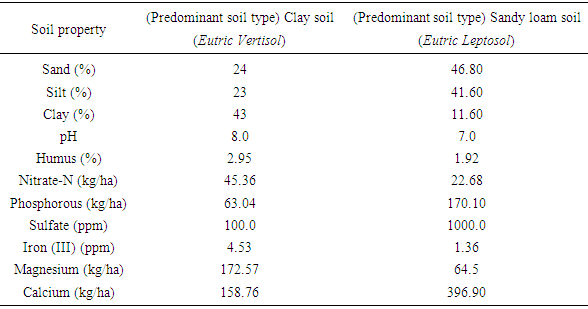-
Paper Information
- Next Paper
- Paper Submission
-
Journal Information
- About This Journal
- Editorial Board
- Current Issue
- Archive
- Author Guidelines
- Contact Us
International Journal of Agriculture and Forestry
p-ISSN: 2165-882X e-ISSN: 2165-8846
2016; 6(4): 142-151
doi:10.5923/j.ijaf.20160604.02

Comparing the Macro-aggregate Stability of Two Tropical Soils: Clay Soil (Eutric Vertisol) and Sandy Loam Soil (Eutric Leptosol)
David Lomeling, Alex L. Modi, Simon M. Kenyi, Mandlena C. Kenyi, George M. Silvestro, Juma L. Yieb
Department of Agricultural Sciences, College of Natural Resources and Environmental Studies (CNRES), University of Juba, South Sudan
Correspondence to: David Lomeling, Department of Agricultural Sciences, College of Natural Resources and Environmental Studies (CNRES), University of Juba, South Sudan.
| Email: |  |
Copyright © 2016 Scientific & Academic Publishing. All Rights Reserved.
This work is licensed under the Creative Commons Attribution International License (CC BY).
http://creativecommons.org/licenses/by/4.0/

The objective of this work was to compare the macro-aggregate stability of two tropical soils and construe causal relationships between aggregate stability as expressed by both the Coefficient of Vulnerability (Kv) and Water Stable Aggregates (WSA) with some soil chemical properties. A total of twenty samples were collected, ten from each soil type with two replications were conducted and analyzed. The average values were then used to estimate both parameters. Aggregate stability was measured using both the modified Le Bissonnais wet sieving method and the slaking test that compared the resistance of macro-aggregates to mechanical breakdown. The WSA for the sandy loam soil (E. Leptosol) was about 55.08% as compared to that of the clay soil (E. Vertisol) at 38.07%. Conversely, the Kv for E. Leptosol was about 1.89 and that of the E. Vertisol was about 2.73. The Kruskal-Wallis test for equal medians [(chi)²=9.14, p-value=0.002] revealed that the effect of wet sieving on macro-aggregate stability for both soils was significantly different. Similarly, the pairwise Wilcoxon rank sum test for E. Vertisol (W=30; p-value=0.799) while for E. Leptosol (W=28; p=0.959) within and between group samples of both soils revealed similar effect of wet sieving on macro-aggregate stability. Noticeable differences were also observed in the degree and rate of slaking. Slaking was faster in E. Vertisol than in the E. Leptosol due in part to the comparatively lower levels of calcium and sulfate in the former. Using the Principal Component Analysis (PCA) as shown by the scatter plot further revealed that both sand and clay components as well as phosphorus (P), magnesium (Mg) and calcium (Ca) had positive effects on macro-aggregate stability for the E. Leptosol whereas only calcium and sulfate had both positive effects on macro-aggregate stability for the E. Vertisol. To a larger extent, pH, humus, sulfate (SO4), iron (Fe-III) and sand did not favor the Kv for both soils.
Keywords: Coefficient of Vulnerability, Water Stable Aggregates, Slaking, Principal Component Analysis, Wet
Cite this paper: David Lomeling, Alex L. Modi, Simon M. Kenyi, Mandlena C. Kenyi, George M. Silvestro, Juma L. Yieb, Comparing the Macro-aggregate Stability of Two Tropical Soils: Clay Soil (Eutric Vertisol) and Sandy Loam Soil (Eutric Leptosol), International Journal of Agriculture and Forestry, Vol. 6 No. 4, 2016, pp. 142-151. doi: 10.5923/j.ijaf.20160604.02.
Article Outline
1. Introduction
- Soil aggregate stability may be used as an indicator to express the ability of a soil to sustain mechanical breakdown. It is an attribute that is contingent on the shear strength of a soil [1, 2]; on the amounts and forms of organic matter prevalent in a soil [3] on the biochemical composition of plant residues and influences on soil´s functional properties like soil permeability [4]; on vegetation cover [5]; on root length density [6]; on susceptibility to surface runoff during heavy precipitation events [7]; on soil´s structure [8]; on soil erosion [9]. Tillage practice appears to be one major activity that breaks down soil aggregation and so aggregate stability. It was found out that the aggregate stability decreased due to tillage [10, 11]. There were also significant differences in soil aggregates stability in orchards as well as under perennial cropping; in fallow soils [12]; in soils under annual cropping [13, 14]. In South Sudan and in particular the areas around Juba County, deforestation due to increasing demand for agricultural land, infrastructural projects like settlements, roads and recreational facilities coupled with poor management practices has led to deterioration of the soils functional properties. Though no empirical studies have been conducted on the state of aggregate stability of soils around Juba County, the increasing population pressure caused by the current political crisis has had an adverse effect on the ecosystem. Some of the impacts are increased surface compaction and penetration resistance, susceptibility to erosion especially during the rainy season.Elsewhere aggregate stability and so good soil structure for sustainable agricultural production as well as preservation of environmental quality has been studied by [15]. Aggregate stability in the topsoil layer (0-5cm) has been closely correlated to susceptibility to soil erodibility [16]. Invariably, soil aggregate stability has been used to characterize the functional properties of a soil. However, qualifying and quantifying a soil´s aggregate stability often suffers from a number of limitations that are both exogenous (climate, soil temperature, organic matter) and intrinsic (clay minerals, sesquioxides, exchangeable cations) in nature. Main existing problems are laboratory based as most soil samples have to be extruded from their sites and be transported to the laboratory for analysis [17]; scale and spatial variability [18]. Various indices have been used in the estimation of aggregate stability of soils such as the mean weight diameter (MWD) [19]; geometric mean diameter (GMD); Water Stable Aggregates (WSA); Coefficient of Vulnerability (Kv); Aggregate Stability Index (ASItest) [20]. Equally, the stability of micro-aggregates against mechanical breakdown and dispersion may be expressed in terms of Clay Flocculation Index (CFI) and the Aggregated Silt and Clay (ASC) which were both applied to determine soil loss in parts of south-eastern Nigeria [21]. Although much research has been done on estimating the aggregate stability of tropical soils, no much literature reveals the choice of any single stability, instability index or method that is generic for all types of soil micro- and macro-aggregates. According to the hierarchical aggregate stability theory, there are four main mechanisms that cause aggregate breakdown: 1) slaking due to compression of entrapped air during fast/sudden wetting; 2) differential swelling and shrinkage during slow wetting and drying; 3) raindrop impact 4) physicochemical dispersion due to osmotic stress. However, the theory has less applicability depending on: soil age (highly weathered tropical soils with Al-Fe sesquioxides), type and composition of organic matter, soil texture, etc. Some studies have measured the aggregate stability using a modified high-energy moisture characteristic method which involved carefully controlling the wetting rate (whether fast or slow) of air-dry aggregates under suction and the degree of aggregate break-down measured from the high-energy moisture-release curves [22]. The aggregate stability was then measured as the ratio of fast structural index to slow structural index. Other methods included the wettability of 3-5mm sized aggregates using the water drop penetration time (WDPT) suggested by [23]; the Molarity of Ethanol Droplet (MED) method for soils with low repellence suggested by [24]; modified wet sieving method using atomized spray [25]; and the application of low intensity ultra-sonic vibration on 0.2-2 mm macro-aggregates by [26, 27]. In this research, knowledge on the macro-aggregate stability of both major soil types prevalent in Juba County would deepen our understanding on the ability of these soils in resisting mechanical breakdown due to water erosion especially during the rainy season. The objectives of this paper were to (i) investigate the changes in soil macro-aggregate stability as measured by the both Water Stable Aggregates (WSA) and Coefficient of Vulnerability (Kv) during wet sieving of samples of both tropical soils, (ii) investigate the pertinence of wet sieving as an indispensable method in explaining susceptibility of macro-aggregates to slaking.
2. Materials and Methods
- Black Cotton clay soil (E. Vertisol) from a 0-30 cm depth was collected from Lologo 2 village, one of the low areas close to the River Nile, about 5 km south of the University of Juba and on the west bank of the River Nile. The sample site is in front of Central Equatoria State Children’s Reformatory Centre about one kilometer west of the River Nile, South Sudan. Sandy loam (E. Leptosol) was collected from the Research and Demonstration farm of the Department of Agricultural Sciences, University of Juba.
2.1. Particle Size Distribution
- Determination of the particle size distribution of the two different tropical soil samples was in accordance with the revised procedures described by [28]. Sixty-four (64 gm) of macro-aggregate soil sample (> 2.5 mm) with diameter was placed into a set of well-arranged Eijkelkamp sieves with the uppermost mesh having 2 mm and bottom last 0.063 mm (2.0; 1.0; 0.5; 0.25; 0.125 and 0.063 mm. The samples were mechanically shaken and sieved and the different fractions collected. Only the >2 mm macro-aggregates were retained for the WSA an Kv test while the rest < 2 mm were then discarded.
2.2. Chemical Analysis
- The chemical analyses of soil samples were conducted using the LaMotte Soil Testing Kit STH-4 Outfit (Code 5029). The soil nutrients and parameters analyzed for both soils were: pH, nitrate-nitrogen, phosphorus, sulfate (SO4), iron (III), humus content, magnesium and calcium.
|
2.3. Soil Aggregate Slaking and Test
- To determine the rate of aggregate slaking and dispersion, 15 grams of air dried soil aggregates with diameter >2 mm from each soil types were placed in petri dishes half filled with rain water. Observations were taken using a digital camera after every 20, 30, 40 minutes and then after 24 hours. The rate of slaking was noted and compared for both soil types.
2.4. Aggregate Stability Test
- Aggregate stability test for both tropical soils were conducted using the modified method of [9]. 15gm of soil aggregates >2.5mm diameter of either soil samples placed onto a top sieve with mesh of 2mm diameter. The other sieves were stacked together in a column descending in order of mesh size. The entire set up was then lowered into and raised from a bucket containing distilled water several times for 60 sec. The remaining stable soil aggregates in the top 2 mm diameter mesh were then transferred to an oven at 110°C for drying for a period of 10mins and then weighed again to obtain the weight of water stable aggregates (WSA). The percentage weight of the 2 mm water stable aggregates (WSA %) and Coefficient of Vulnerability (KV) was then calculated.The percentage weight of macro-aggregates expressed as Water Stable Aggregates, (WSA %) and the Coefficient of Vulnerability, (KV) excluding sand were calculated as;
 | (1) |
 | (2) |
3. Results and Discussion
- Whereas the mean WSA values for the sandy loam soil was higher than that of the clay soil (Table 2), it was the contrary for Kv with mean values at 1.89 and 2.73 respectively. The effect of wet sieving on stability of soil macro-aggregate was significant for both soil samples when the Kruskal–Wallis test for equal medians at: (chi)² = 9.143; df = 1; p-value = 0.003) was used. Considering the one-sample test within and between group samples of both soils, the pairwise Wilcoxon rank sum test also revealed that the effect of wet sieving on aggregate stability was significantly different (W = 55; p-value=1.95x10-3).
|
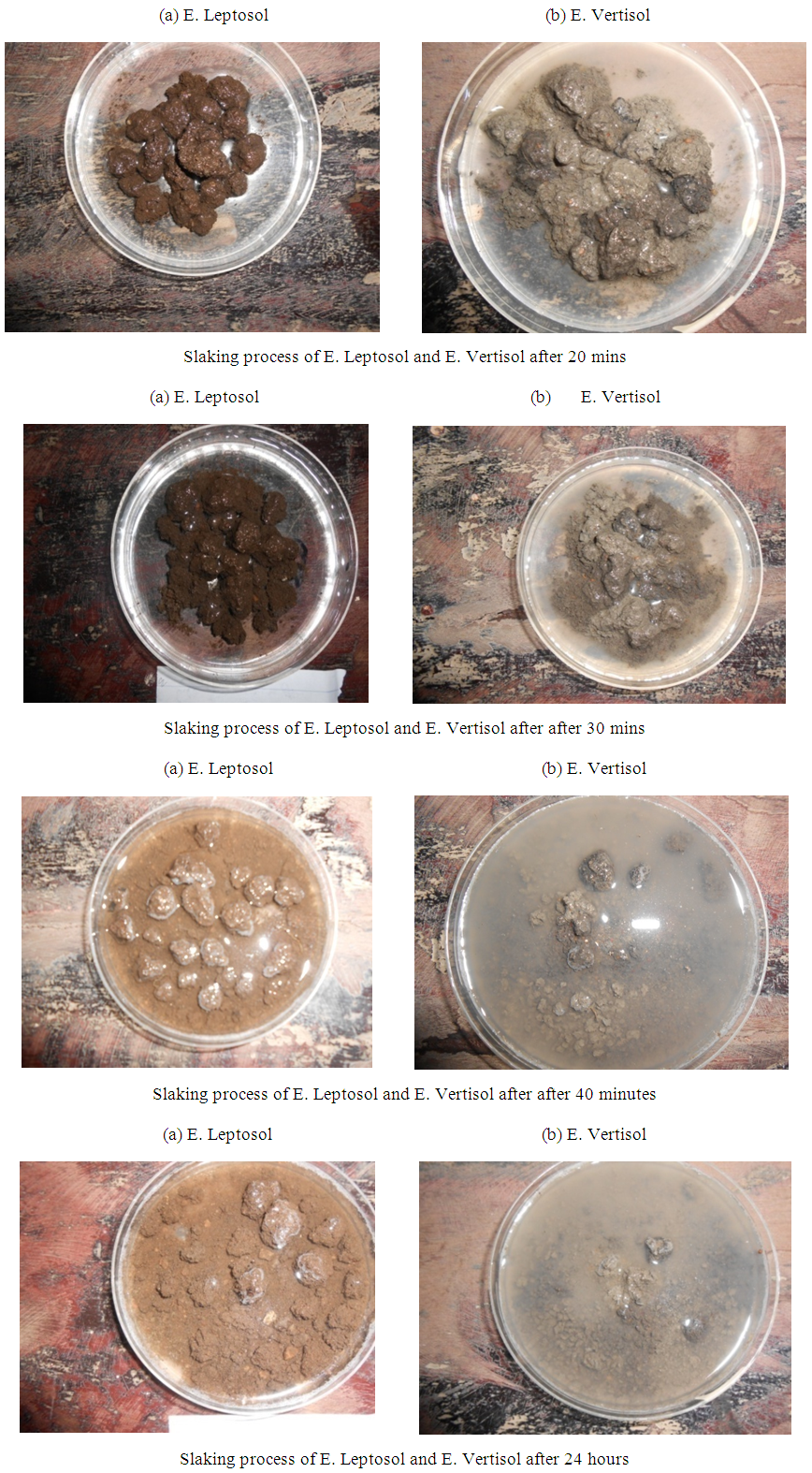 | Figure 1. Photos showing slaking process of E. Leptosol and E. Vertisol during a 24 hour persiod |
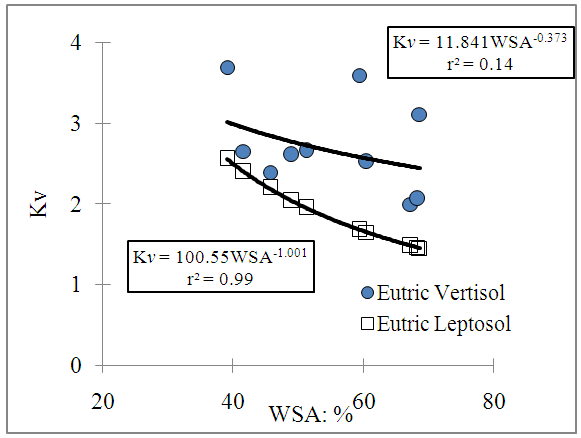 | Figure 2. Relationship between Coefficient of Vulnerability (Kv) and Water Stable Aggregates (WSA) of two tropical soils |
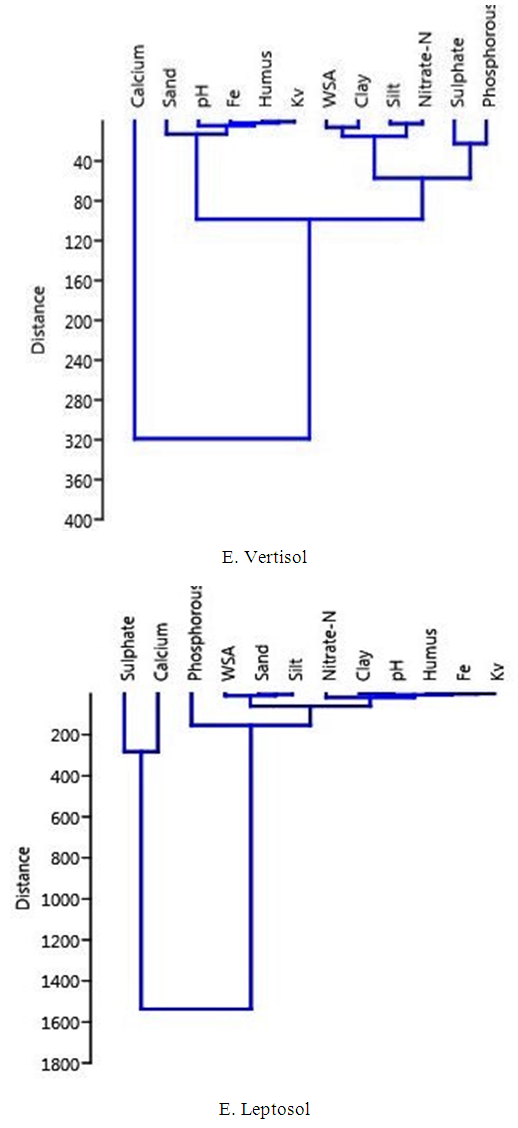 | Figure 3. Hierarchical dendrograms showing dissimilarity in both E. Vertisol and E. Leptosol as influenced by chemical and physical properties |
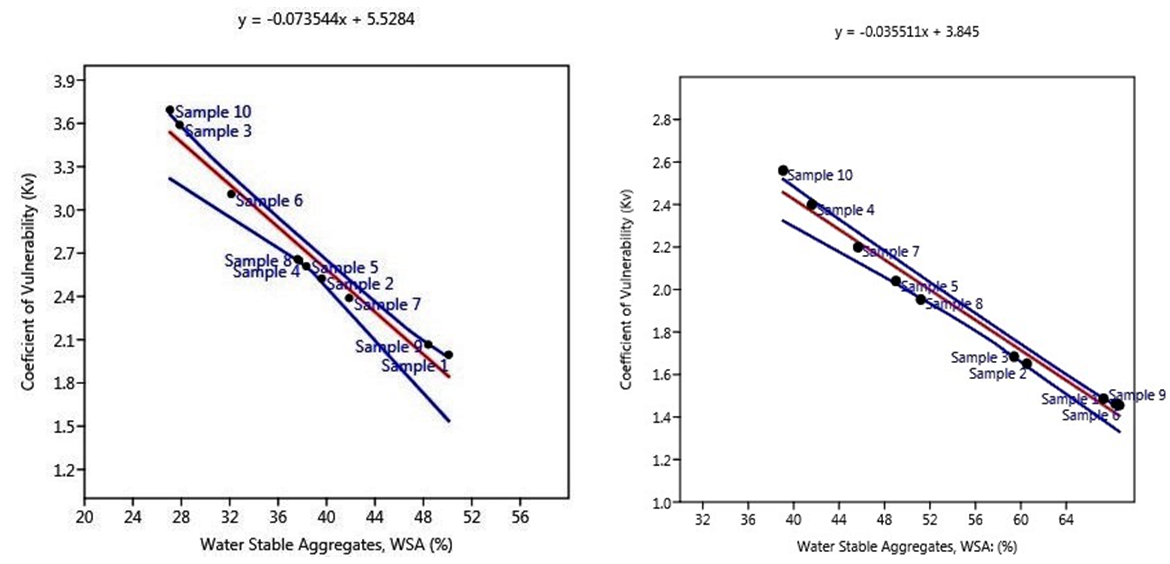 | Figure 4. Relationship between Water Stable Aggregates and Kv of samples of E. Leptosol (left) and E. Vertisol (right) with blue lines showing 95% confidence level |
3.1. Significance of Soil Chemical and Physical Properties
- The significance in terms of antagonistic or synergistic effects of either one or several factors on WSA and Kv was studied using the scatter plot (Figure 5). Both Ca and SO4 had positive loadings on the E. Vertisol, whereas all physical properties such as pH, Humus, WSA, Kv, sand, silt and clay contents as well as chemical elements such as Mg, Fe and P had negative loadings. Conversely, NO3-N, clay, silt, WSA, Mg, P and Ca had positive loadings whereas humus, pH, sand, Fe and Kv had negative loadings on E. Leptosol. Similar results on the effects on silt and clay contents of Orthic Luvisol on aggregate vulnerability to destruction during wetting were reported by [45]. However, both clay and silt contents showed negative influence on macro-aggregate stability in E. Vertisol, this was on the contrary for E. Leptosol which showed increased macro-aggregate stability with both clay and silt contents and low macro-aggregate stability with sand. The findings in our study are in line with earlier works of [31, 44] who showed that both soil constituents had major influences on soil aggregate stability. According to Harmonized World Soil Data (HWSD) Viewer 1.2, the Cation Exchange Capacity (CEC) is comparatively high at about 68 cmol/kg and the E. Vertisol may be classified as a “high activity clay” (HAC) [46] soil consisting of 2:1 expansible montmorillonite and smectite clay minerals. However, the comparatively easy dispersive nature of E. Vertisol during slaking test would suggest that much of the clay mineral was illite containing high amounts of Mg, [47, 48]. On the contrary, [49] argues that increase of clay contents does not always lead to soil aggregation especially that smectites have a more dispersive tendency than illite or kaolinite. The use of the Principal Component Analysis (PCA) as shown by the scatter plot in Figure 5, further showed that both silt and clay components as well as P and NO3-N did not favor macro-aggregate stability for the E. Vertisol whereas they favored macro-aggregate stability for the E. Leptosol. To a larger extent, the pH, humus, SO4 Fe and sand did not favor the Kv for the E. Leptosol. Several other similar studies on the relationship between the percentage of water-stable aggregates and soil organic matter have been reported by [50, 51, 52]. The NO3-N had positive effect on aggregate stability which is in agreement with earlier and similar studies of [29, 43, 53]. In our study, the type, amounts and fraction of organic matter may have not been sufficient enough to enhance aggregate stability especially in E. Vertisol. No measurement of the relative quantities of oxidized humic substances or polysaccharides (microbial gums) contained in the organic carbon as well as N-amino acids and ammonium ions in the humus were conducted. However, the negative loadings of humus at both pH values of 7 and 8 for E. Leptosol and E. Vertisol respectively would suggest that the levels of binding organo-complexing humic and N-aminated compounds was significantly low to warrant soil aggregate stabilization. Magnesium tended to favor aggregate stability in E. Leptosol than in Vertisol and no concrete reasons were attributable to this phenomenon. Presumably, high levels of Mg in the E. Vertisol tended to bind with more carboxylic, hydroxyl and amine functional groups thereby increasing the susceptibility to dispersion during wetting.
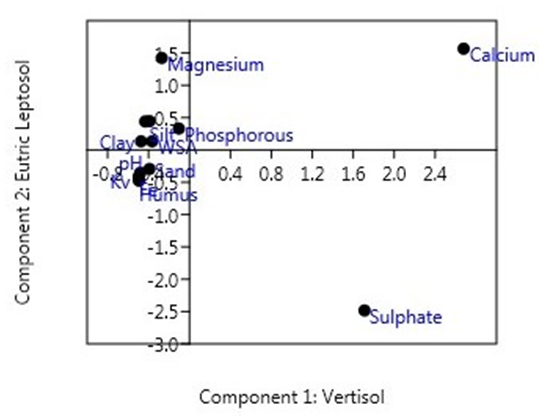 | Figure 5. Scatter plot with Eigenvalues showing soil chemical and physical properties of both tropical soils |
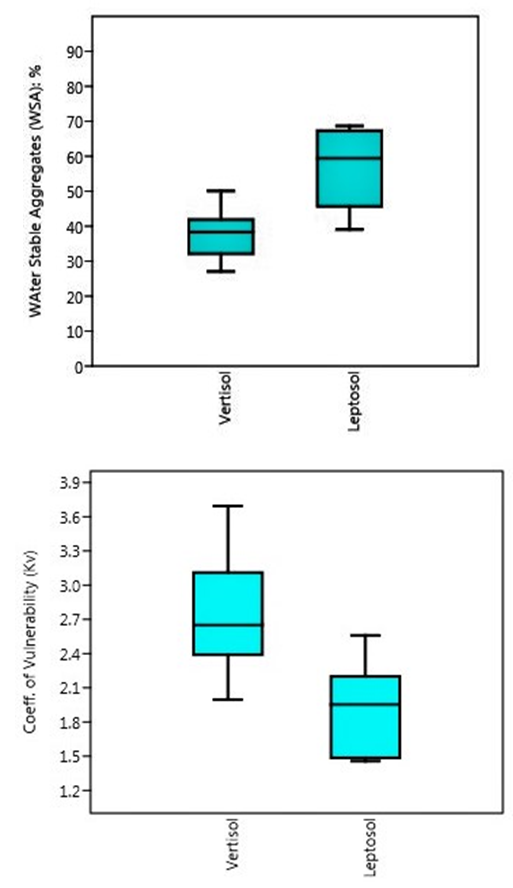 | Figure 6. Water Stable Aggregates (WSA) and the Coefficient of Vulnerability for both tested soils |
4. Conclusions
- 1. Use of Water Stable Aggregates (WSA) and the Coefficient of Vulnerability (Kv) as aggregate stability indices for both soils: sandy loam and clay soils showed differences resulting from wet sieving. 2. The aggregate stability index WSA and Kv expressed as a linear function, allowed for establishment of significant differences between both tropical soils. The E. Leptosol showed greater macro-aggregate stability, WSA and lower Kv than the E. Vertisol with a lower WSA and higher Kv.3. The use of hierarchical cluster analysis and the scatter plot of the PCA revealed differences in aggregate stability due to variations in the physical properties as well as chemical constituents of either tropical soil. The aggregate stability index WSA for E. Leptosol exhibited mainly a strong relationship with sand and silt components whereas for the E. Vertisol was with clay and silt. The Kv by E. Leptosol was influenced to a greater extent by Fe whereas this for the E. Vertisol by humus.
 Abstract
Abstract Reference
Reference Full-Text PDF
Full-Text PDF Full-text HTML
Full-text HTML